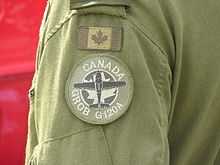Grob G 120

The Grob G 120 is a two seated training and aerobatic low-wing aircraft with a carbon composite airframe, built by Grob Aircraft. It is based on the Grob G 115TA training aircraft and is specially designed for military and civil pilots training. It has a tricycle landing gear and a low tailplane.
The first operator of the aircraft was Lufthansa Flight Training.[citation needed]
Design and development
The airframe is made of carbon fibre reinforced plastic and is stressed to +6/-4g. Its minimum service life is just over 15,000 flight hours.[citation needed]
The cockpit provides room for students wearing military equipment and helmets. The plane is equipped with movable seats and rudder pedals and an air conditioning system. A second thrust lever is available.[citation needed]
Variants
- G 120A
- Piston powered version with a Lycoming AEIO-540-D4D5 six cylinder, four-stroke, air-cooled piston aircraft engine producing 260 hp (194 kW).[1]
- G 120TP
- Turboprop powered version with a Rolls Royce 250-B17F aircraft engine producing 456 shp (340 kW) for take-off.[2] The Indonesian Air Force signed a contract for about 18 G 120TP trainers in the elementary and basic flying training roles in September 2011 at a cost of approx US$4 million each. The Argentinian AF also bought 10 examples of the G120TP one of which landed gear-up after just 20 hours of flying. The Indian AF recently bought the PC7M Mk2 in preference to the G120TP as it includes local manufacture.[3]
Operators


 Canada
Canada- Royal Canadian Air Force[4]
 Germany
Germany- German Air Force[5]
 France
France- French Air Force[4]
 Israel
Israel- Israeli Air Force[4]
 Kenya
Kenya- Kenya Air Force:[6] 6 (+6 option)
Specifications (G 120A)
Data from Jane's All The World's Aircraft 2003–2004[7]
General characteristics
- Crew: Two
- Length: 8.605 m (28 ft 3 in)
- Wingspan: 10.19 m (33 ft 5 in)
- Height: 2.57 m (8 ft 5 in)
- Wing area: 13.29 m2 (143.1 sq ft)
- Airfoil: Eppler E884
- Empty weight: 960 kg (2,116 lb)
- Gross weight: 1,440 kg (3,175 lb)
- Max takeoff weight: 1,490 kg (3,285 lb) (Utility)[8]
- Fuel capacity: 256 litres (56 imp gal; 68 US gal)
- Powerplant: 1 × Lycoming AEIO-540-D4D5 air-cooled flat-six, 190 kW (260 hp)
- Propellers: 3-bladed Hartzell HC-C3YR-1RF/F7663R, 1.98 m (6 ft 6 in) diameter [8]
Performance
- Maximum speed: 319 km/h; 198 mph (172 kn)
- Cruise speed: 307 km/h; 191 mph (166 kn) at 75% power (5,000 ft (1,500 m))
- Stall speed: 102 km/h; 63 mph (55 kn) with full flaps
- Never exceed speed: 435 km/h; 270 mph (235 kn)
- Range: 1,537 km; 955 mi (830 nmi) at 8,000 ft (2,400 m) and 45% power)
- Endurance: 6.35 hours at 10,000 ft and maximum endurance power setting[8]
- Service ceiling: 5,486 m (18,000 ft)
- g limits: +6/-4G
- Rate of climb: 6.5 m/s (1,280 ft/min)
Avionics
- Garmin avionics
See also
- Aircraft of comparable role, configuration and era
- Aermacchi SF.260
- Beechcraft T-34 Mentor
- ENAER T-35 Pillán
- Fuji T-3
- Lasta 95
- PAC CT/4 Airtrainer
- Socata TB-31 Omega
References
- ↑ Grob Aircraft (undated). "The basic training aircraft success story". Retrieved 20 March 2012.
- ↑ Grob Aircraft (undated). "G 120 TP – The intelligent training solution of the 21st century". Retrieved 20 March 2012.
- ↑ "Indonesian win launches Grob's G120TP". FlightGlobal. 2011-09-19. Retrieved 2012-04-01.
- ↑ 4.0 4.1 4.2 "Customers Worldwide". Grob Aircraft, Retrieved 1 September 2012.
- ↑ Grob G120A Basic Trainer Aircraft, Germany,
- ↑ Augsburger Allgemeine (German regional daily)
- ↑ Jackson 2003, pp. 166–167.
- ↑ 8.0 8.1 8.2 Grob Aircraft (undated). "Grob 120A Technical Specifications". Retrieved 20 March 2012.
- Grob G 115,120 and 140 Information brochure and Technical Datasheet (Grob Aerospace Sales Department, 2004)
- Jackson, Paul. Jane's All The World's Aircraft 2003–2004. Coulsdon, UK: Jane's Information Group, 2003. ISBN 0-7106-2537-5.
External links
| Wikimedia Commons has media related to Grob G120. |
- Grob G120A Basic Trainer Aircraft, Germany(Air force Technology)
- Grob 120A official website
- Grob 120TP official website
- Grob G120TP Trainer Aircraft, Germany(Air force Technology)
| |||||
| ||||||||||||||